Reducing Food Waste in the Retail Supply Chains by Improving Efficiency of Logistics Operations
Abstract
1. Introduction
2. Literature Survey
2.1. Food Waste Reduction in the Context of Sustainable Supply Chain Management
2.2. RFID in Logistics and Supply Chains
2.3. Simulation Modelling of Logistics Processes
3. Research
3.1. Problem Description
3.2. Problem Statement and Solution Proposal
3.3. Structure of the Simulation Model—Model Parameters
4. Simulation Results and Discussion
- Stocks in the chain are reduced on average by 11.07% (20.54% in the supermarket and 8.69% at the producer);
- The product flow time through the chain is reduced by 11%, i.e., from 11 to 10 days;
- Inventory costs are reduced by 8.69% for the producer and 20.60% in retail;
- Product storage costs are reduced by 8.69%.
5. Conclusions
Author Contributions
Funding
Institutional Review Board Statement
Informed Consent Statement
Data Availability Statement
Acknowledgments
Conflicts of Interest
References
- Global Food Losses and Food Waste—Extent, Causes and Prevention; Food and Agriculture Organization of the United Nations: Rome, Italy, 2011; Available online: http://www.fao.org/3/i2697e/i2697e.pdf (accessed on 21 December 2020).
- Mendoza-Fong, J.R.; García-Alcaraz, J.L.; Macías, E.J.; Hernández, N.L.I.; Díaz-Reza, J.R.; Fernández, J.B. Role of information and communication technology in green supply chain implementation and companies’ performance. Sustainability 2018, 10, 1793. [Google Scholar] [CrossRef]
- Evangelista, R.; Guerrieri, P.; Meliciani, V. The economic impact of digital technologies in Europe. Econ. Innov. New Technol. 2014, 23, 802–824. [Google Scholar] [CrossRef]
- Nagy, J.; Oláh, J.; Erdei, E.; Máté, D.; Popp, J. The role and impact of industry 4.0 and the internet of things on the business strategy of the value chain—The case of Hungary. Sustainability 2018, 10, 3491. [Google Scholar] [CrossRef]
- Chae, B.K.; Olson, D.L. Business analytics for supply chain: A dynamic-capabilities framework. Int. J. Inf. Technol. Decis. Mak. 2013, 12, 9–26. [Google Scholar] [CrossRef]
- Kaipia, R.; Dukovska-Popovska, I.; Loikkanen, L. Creating sustainable fresh food supply chains through waste reduction. Int. J. Phys. Distrib. Logist. Manag. 2013, 43, 262–276. [Google Scholar] [CrossRef]
- Liljestrand, K. Logistics solution for reducing food waste. Int. J. Phys. Distrib. Logist. Manag. 2017, 47, 318–339. [Google Scholar] [CrossRef]
- Katajajuuri, J.-M.; Silvennoinen, K.; Hartikainen, H.; Heikkila, L.; Reinikainen, A. Food waste in the Finish food chain. J. Clean. Prod. 2014, 73, 322–329. [Google Scholar] [CrossRef]
- Goodman-Smith, F.; Mirosa, M.; Skeaff, S. A mixed-methods study of retail food waste in New Zealand. Food Policy 2020, 92, 101845. [Google Scholar] [CrossRef]
- Schneider, F.; Lebersorger, S.; Scherhaufer, S. Food waste at the food retail -statistical approach to identifying influencing factors. In Proceedings of the Fourteenth International Waste Management and Landfill Symposium, Cagliari, Italy, 30 September–4 October 2013; Abstract, 59. Full paper on CD. Cossu, R., He, P., Kjeldsen, P., Matsufuji, Y., Reinhart, D., Stegmann, R., Eds.; CISA Publisher: Padova, Italy, 2013. [Google Scholar]
- CSCMP. Available online: https://cscmp.org/CSCMP/Educate/SCM_Definitions_and_Glossary_of_Terms/CSCMP/Educate/SCMDefinitions_and_Glossary_of_Terms.aspx?hkey=60879588-f65f-4ab5-8c4b-6878815ef921 (accessed on 4 March 2019).
- Martins, C.L.; Pato, M.V. Supply chain sustainability: A tertiary literature review. J. Clean. Prod. 2019, 225, 995–1016. [Google Scholar] [CrossRef]
- Winkelhaus, S.; Grosse, E.H. Logistics 4.0: A systematic review towards a new logistics system. Int. J. Prod. Res. 2020, 58, 18–43. [Google Scholar] [CrossRef]
- Mincer, J. The color of money: Sustainability has become more than a buzzword among corporations. It has become smart business. Wall Street Journal, 6 October 2008. Available online: http://online.wsj.com/article/SB122305414262702711.html (accessed on 15 February 2021).
- Ansari, Z.N.; Kant, R. A state-of-art literature review reflecting 15 years of focus on sustainable supply chain management. J. Clean. Prod. 2017, 142, 2524–2543. [Google Scholar] [CrossRef]
- Wang, J.; Zhang, D. Study on the mechanism of logistics system sustainability. In Proceedings of the 2007 IEEE International Conference on Automation and Logistics, Jinan, China, 18–21 August 2007; pp. 2165–2169. [Google Scholar]
- Liu, S.; Kasturiratne, D.; Moizer, J. A hub-and-spoke model for multidimensional integration of green marketing and sustainable supply chain management. Ind. Mark. Manag. 2012, 41, 581–588. [Google Scholar] [CrossRef]
- Davis-Sramek, B.; Thomas, R.W.; Fugate, B.S. Integrating behavioral decision theory and sustainable supply chain management: Prioritizing economic, environmental, and social dimensions in carrier selection. J. Bus. Logist. 2018, 39, 87–100. [Google Scholar] [CrossRef]
- Seuring, S.; Mülle, M. From a literature review to a conceptual framework for sustainable supply chain management. J. Clean. Prod. 2008, 16, 1699–1710. [Google Scholar] [CrossRef]
- Tajbakhsh, A.; Hassini, E. Performance measurement of sustainable supply chains: A review and research questions. Int. J. Product. Perform. Manag. 2015, 64, 744–783. [Google Scholar] [CrossRef]
- United Nations. Transforming our World: The 2030 Agenda for Sustainable Development. Available online: https://sustainabledevelopment.un.org/post2015/transformingourworld (accessed on 12 December 2020).
- Grizzetti, B.; Pretato, U.; Lassaletta, L.; Billen, G.; Garnier, J. The contribution of food waste to global and European nitrogen pollution. Environ. Sci. Policy 2013, 33, 186–195. [Google Scholar] [CrossRef]
- Food Losses and Waste in the Context of Sustainable Food Systems; HLPE Report 8, June 2014. Available online: www.fao.org/cfs/cfs-hlpe (accessed on 10 December 2020).
- Rosenlund, J.; Nyblom, A.; Ekholm, H.M. The emergence of food waste as an issue in Swedish retail. Br. Food J. 2020, 122, 3283–3296. [Google Scholar] [CrossRef]
- Reducing Food Waste: How Can Retailers Help? Oliver Wyman, Marsh & McLennan Companies: New York, NY, USA, 2014; Available online: https://www.oliverwyman.com/content/dam/oliver-wyman/global/en/2014/jul/OW_Reducing_Food_Waste.pdf (accessed on 25 May 2021).
- Cicatiello, C.; Franco, S.; Pancino, B.; Blasi, E.; Falasconi, L. The dark side of retail food waste: Evidences from in-store data. Resour. Conserv. Recycl. 2017, 125, 273–281. [Google Scholar] [CrossRef]
- Giuseppe, A.; Mario, E.; Cinzia, M. Economic benefits from food recovery at the retail stage: An application to Italian food chains. Waste Manag. 2014, 34, 1306–1316. [Google Scholar] [CrossRef] [PubMed]
- Moraes, C.C.; Oliveira Costa, F.H.; Pereira, C.R.; Silva, A.L.; Delai, I. Retail food waste: Mapping causes and reduction practices. J. Clean. Prod. 2020, 256, 120124. [Google Scholar] [CrossRef]
- Duong, L.N.K.; Wood, L.C.; Wang, W.Y.C. Effects of consumer demand, product lifetime, and substitution ratio on perishable inventory management. Sustainability 2018, 10, 1559. [Google Scholar] [CrossRef]
- Lin, C.S.K.; Koutinas, A.A.; Stamatelatou, K.; Mubofu, E.B.; Matharu, A.S.; Kopsahelis, N.; Pfaltzgraff, L.A.; Clark, J.H.; Papanikolaou, S.; Kwan, T.H.; et al. Current and future trends in food waste valorization for the production of chemicals, materials and fuels: A global perspective. Biofuels Bioprod. Biorefining 2014, 8, 686–715. [Google Scholar] [CrossRef]
- Kummu, M.; De Moel, H.; Porkka, M.; Siebert, S.; Varis, O.; Ward, P.J. Lost food, wasted resources: Global food supply chain losses and their impacts on freshwater, cropland, and fertiliser use. Sci. Total Environ. 2012, 438, 477–489. [Google Scholar] [CrossRef] [PubMed]
- The Environmental Food Crisis—The Environment’s Role in Averting Future Food Crises; United Nations Environment Program (UNEP): Arendal, Norway, 2009. Available online: https://gridarendal-website-live.s3.amazonaws.com/production/documents/:s_document/221/original/FoodCrisis_lores.pdf?1486728701 (accessed on 11 December 2020).
- Sakoda, G.; Takayasu, H.; Takayasu, M. Data science solutions for retail strategy to reduce waste keeping high profit. Sustainability 2019, 11, 3589. [Google Scholar] [CrossRef]
- Horos, I.K.; Ruppenthal, T. Avoidance of food waste from a grocery retail store owner’s perspective. Sustainability 2021, 13, 550. [Google Scholar] [CrossRef]
- Eriksson, M.; Strid, I.; Hansson, P.A. Food losses in six Swedish retail stores: Wastage of fruit and vegetables in relation to quantities delivered. Resour. Conserv. Recycl. 2012, 68, 14–20. [Google Scholar] [CrossRef]
- Lebersorger, S.; Schneider, F. Food loss rates at the food retail, influencing factors and reasons as a basis for waste prevention measures. Waste Manag. 2014, 34, 1911–1919. [Google Scholar] [CrossRef] [PubMed]
- Brancoli, P.; Rousta, K.; Bolton, K. Life cycle assessment of supermarket food waste. Resour. Conserv. Recycl. 2017, 118, 39–46. [Google Scholar] [CrossRef]
- Bauernhansl, T. Die Vierte Industrielle Revolution—Der Weg in ein Wertschaffendes Produktionsparadigma. In Industrie 4.0 in Produktion, Automatisierung und Logistik, Anwendung Technologien Migration; Bauernhansl, T., Ten Hompel, M., Birgit Vogel-Heuser, B., Eds.; Springer Vieweg: Wiesbaden, Germany, 2014; pp. 5–35. [Google Scholar]
- Kache, F.; Seuring, S. Challenges and opportunities of digital information at the intersection of big data analytics and supply chain management. Int. J. Oper. Prod. Manag. 2017, 37, 10–36. [Google Scholar] [CrossRef]
- Tu, Y.J.; Zhou, W.; Piramuthu, S. A novel means to address RFID tag/item separation in supply chains. Decis. Support Syst. 2018, 115, 13–23. [Google Scholar] [CrossRef]
- VDI Nachrichten, 49. RFID Technik Fehlen Standards; Beuth Verlag: Berlin, Germany, 2004. [Google Scholar]
- Sarac, A.; Absi, N.; Dauzere-Peres, S. A literature review on the impact of RFID technologies on supply chain management. Int. J. Prod. Econ. 2010, 128, 77–95. [Google Scholar] [CrossRef]
- Shin, S.; Eksioglu, B. Effects of RFID technology on efficiency and profitability in retail supply chains. J. Appl. Bus. Res. 2014, 30, 633–646. [Google Scholar] [CrossRef]
- Hardgrave, B.C.; Waller, M.; Miller, R.; Walton, S.M. Does RFID Reduce Out of Stocks? A Preliminary Analysis; Working Paper; University of Arkansas: Fayetteville, Arkansas, 2005. [Google Scholar]
- Behrenbeck, K.; Küpper, J.; Magnus, K.H.; Thonemann, V. Zwischen Euphorie und Skepsis—RFID kommt, der Handlungsdruck steigt: Welche Optionen besitzen Konsumgüterhersteller und Einzelhändler? Logist. Heute 2004, 12, 54–55. [Google Scholar]
- Becker, J.; Vilkov, L.; Weiß, B.; Winkelmann, A. A model based approach for calculating the process driven business value of RFID investments. Int. J. Prod. Econ. 2010, 127, 358–371. [Google Scholar] [CrossRef]
- Lee, I.; Lee, B.-C. An investment evaluation of supply chain RFID technologies: A normative modeling approach. Int. J. Prod. Econ. 2010, 125, 313–323. [Google Scholar] [CrossRef]
- Nikoličić, S.; Kilibarda, M.; Atanasković, P.; Duđak, L.; Ivanišević, A. Impact of RFID technology on logistic process efficiency in retail supply chains. Promet-Traffic Transp. 2015, 27, 137–146. [Google Scholar] [CrossRef]
- Bottani, E.; Rizzi, A. Economical assessment of the impact of RFID technology and EPC system on the fast-moving consumer goods supply chain. Int. J. Prod. Econ. 2008, 112, 548–569. [Google Scholar] [CrossRef]
- Zhang, L.H.; Li, T.; Fan, T.J. Radio-frequency identification (RFID) adoption with inventory misplacement under retail competition. Eur. J. Oper. Res. 2018, 270, 1028–1043. [Google Scholar] [CrossRef]
- Ustundag, A.; Tanyas, M. The impacts of Radio Frequency Identification (RFID) technology on supply chain costs. Transp. Res. Part E 2009, 45, 29–38. [Google Scholar] [CrossRef]
- Bhattacharya, M.; Chu, C.-H.; Hayya, J.; Mullen, T. An exploratory study of RFID adoption in the retail sector. Oper. Manag. Res. 2010, 3, 80–89. [Google Scholar] [CrossRef]
- Hardgrave, B.C.; Goyal, S.; Aloysiu, J.A. Improving inventory management in the retail store: The effectiveness of RFID tagging across product categories. Oper. Manag. Res. 2011, 4, 6–13. [Google Scholar] [CrossRef]
- De Kok, A.G.; Van Donselaar, K.H.; Van Woensel, T. A break-even analysis of RFID technology for inventory sensitive to shrinkage. Int. J. Prod. Econ. 2008, 112, 521–531. [Google Scholar] [CrossRef]
- Anandhi, S.; Anitha, R.; Sureshkumar, V. IoT enabled RFID authentication and secure object tracking system for smart logistics. Wirel. Pers. Commun. 2019, 104, 543–560. [Google Scholar] [CrossRef]
- Grunow, M.; Piramuthu, S. RFID in highly perishable food supply chains—Remaining shelf life to supplant expiry date? Int. J. Prod. Econ. 2013, 146, 717–727. [Google Scholar] [CrossRef]
- Verghese, K.; Lewis, H.; Lockrey, S.; Williams, H. The Role of Packaging in Minimising Food Waste in the Supply Chain of the Future; Final Report Prepared for CHEP Australia; RMIT University, Centre for Design: Melbourne, Australia, 2019. [Google Scholar]
- Zmienka, E.; Staniszewski, J. Food management innovations for reducing food wastage-a systematic literature review. Management 2020, 24, 193–207. [Google Scholar] [CrossRef]
- Chauhan, Y. Food waste management with technological platforms: Evidence from Indian food supply chains. Sustainability 2020, 12, 8164. [Google Scholar] [CrossRef]
- Lee, S.; Jung, K. Exploring effective incentive design to reduce food waste: A natural experiment of policy change from community based charge to RFID based weight charge. Sustainability 2017, 9, 2046. [Google Scholar] [CrossRef]
- Karkkainen, M.; Holstrom, J. Wireless product identification: Enabler for handling efficiency, customisation and information sharing. Supply Chain Manag. Int. J. 2002, 7, 242–252. [Google Scholar] [CrossRef]
- Collins, J.D.; Worthington, W.J.; Reyes, P.M.; Romero, M. Knowledge management, supply chain technologies and firm performance. Manag. Res. Rev. 2010, 33, 947–960. [Google Scholar] [CrossRef]
- Maslarić, M.; Nikoličić, S.; Mirčetić, D. Logistics response to the industry 4.0: The physical internet. Open Eng. 2016, 6, 511–517. [Google Scholar] [CrossRef]
- Arunachalam, D.; Niraj Kumar, N.; Kawalek, J.P. Understanding big data analytics capabilities in supply chain management: Unravelling the issues, challenges and implications for practice. Transp. Res. Part E 2018, 114, 416–436. [Google Scholar] [CrossRef]
- Hung, W.Y.; Samsatli, N.J.; Shah, N. Object-oriented dynamic supply-chain modelling incorporated with production scheduling. Eur. J. Oper. Res. 2006, 169, 1064–1076. [Google Scholar] [CrossRef]
- Van der Vorst, J.G. Effective Food Supply Chains: Generating, Modelling and Evaluating Supply Chain Scenarios. Ph.D. Thesis, Wageningen University, Wageningen, The Netherlands, 2000. [Google Scholar]
- Chilmon, B.; Tipi, N.S. Modelling and simulation considerations for an end-to-end supply chain system. Comput. Ind. Eng. 2020, 150, 106870. [Google Scholar] [CrossRef]
- Hoffa-Dabrowska, P.; Grzybowska, K. Simulation modeling of the sustainable supply chain. Sustainability 2020, 12, 6007. [Google Scholar] [CrossRef]
- Kesaraju, V.S.; Ciarallo, F.W. Integrated simulation combining process-driven and event-driven models. J. Simul. 2012, 6, 9–20. [Google Scholar] [CrossRef]
- Persson, F.; Araldi, M. The development of a dynamic supply chain analysis tool—Integration of SCOR and discrete event simulation. Int. J. Prod. Econ. 2009, 121, 574–583. [Google Scholar] [CrossRef]
- Chopra, S. Supply Chain Management: Strategy, Planning and Operation, 7th ed.; Pearson: Boston, MA, USA, 2019. [Google Scholar]
- Cigolini, R.; Pero, M.; Rossi, T.; Sianesi, A. Linking supply chain configuration to supply chain performance: A discrete event simulation model. Simul. Model. Pract. Theory 2014, 40, 1–11. [Google Scholar] [CrossRef]
- Fedorko, G.; Molnar, V.; Honus, S.; Neradilova, H.; Kampf, A.R. The application of simulation model of a milk run to identify the occurrence of failures. Int. J. Simul. Model. 2018, 17, 444–457. [Google Scholar] [CrossRef]
- Jung, H.; Jeong, S. The economic effect of virtual warehouse-based inventory information sharing for sustainable supplier management. Sustainability 2018, 10, 1547. [Google Scholar] [CrossRef]
- Stefanovic, D.; Stefanovic, N.; Radenkovic, B. Supply network modelling and simulation methodology. Simul. Model. Pract. Theory 2009, 17, 743–766. [Google Scholar] [CrossRef]
- Yuan, Y.; Viet, N.; Behdani, B. The impact of information sharing on the performance of horizontal logistics collaboration: A simulation study in an agri-food supply chain. IFAC PapersOnLine 2019, 52, 2722–2727. [Google Scholar] [CrossRef]
- Yao, Y.; Dresner, M. The inventory value of information sharing, continuous replenishment, and vendor-managed inventory. Transp. Res. Part E 2008, 44, 361–378. [Google Scholar] [CrossRef]
- RFID—Perspectives for Germany, The State of Radio Frequency Identification—Based Applications and Their Outlook in National and International Markets; Federal Ministry of Economics and Technology: Berlin, Germany, 2007.
- Angerer, A. The Impact of Automatic Store Replenishment Systems on Retail. Ph.D. Thesis, The University of St. Gallen: St. Gallen, Switzerland, 2005. [Google Scholar]
- Ferguson, M.; Ketzenberg, M.E. Information sharing to improve retail product freshness of perishables. Prod. Oper. Manag. 2006, 15, 57–73. [Google Scholar] [CrossRef]


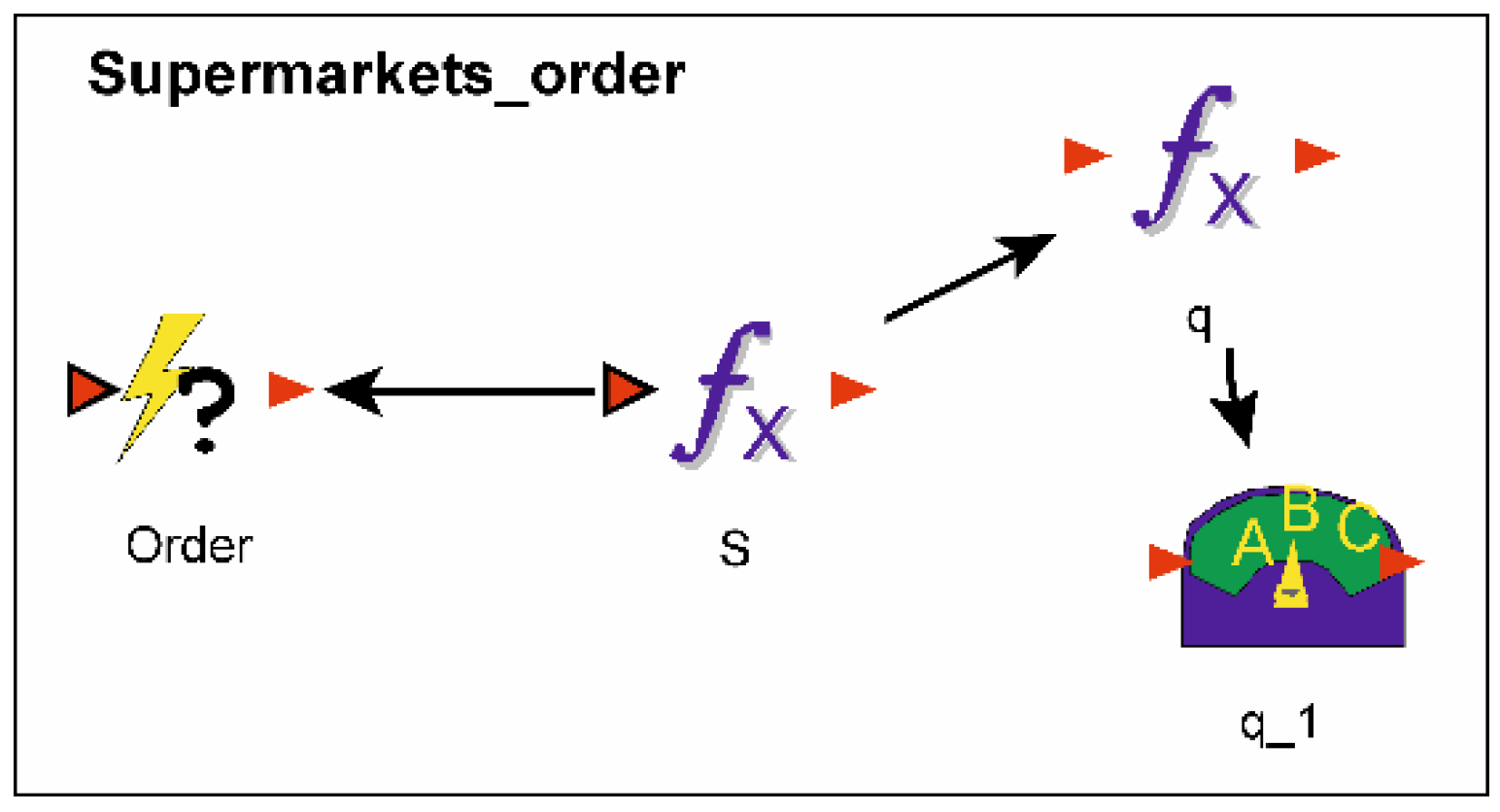
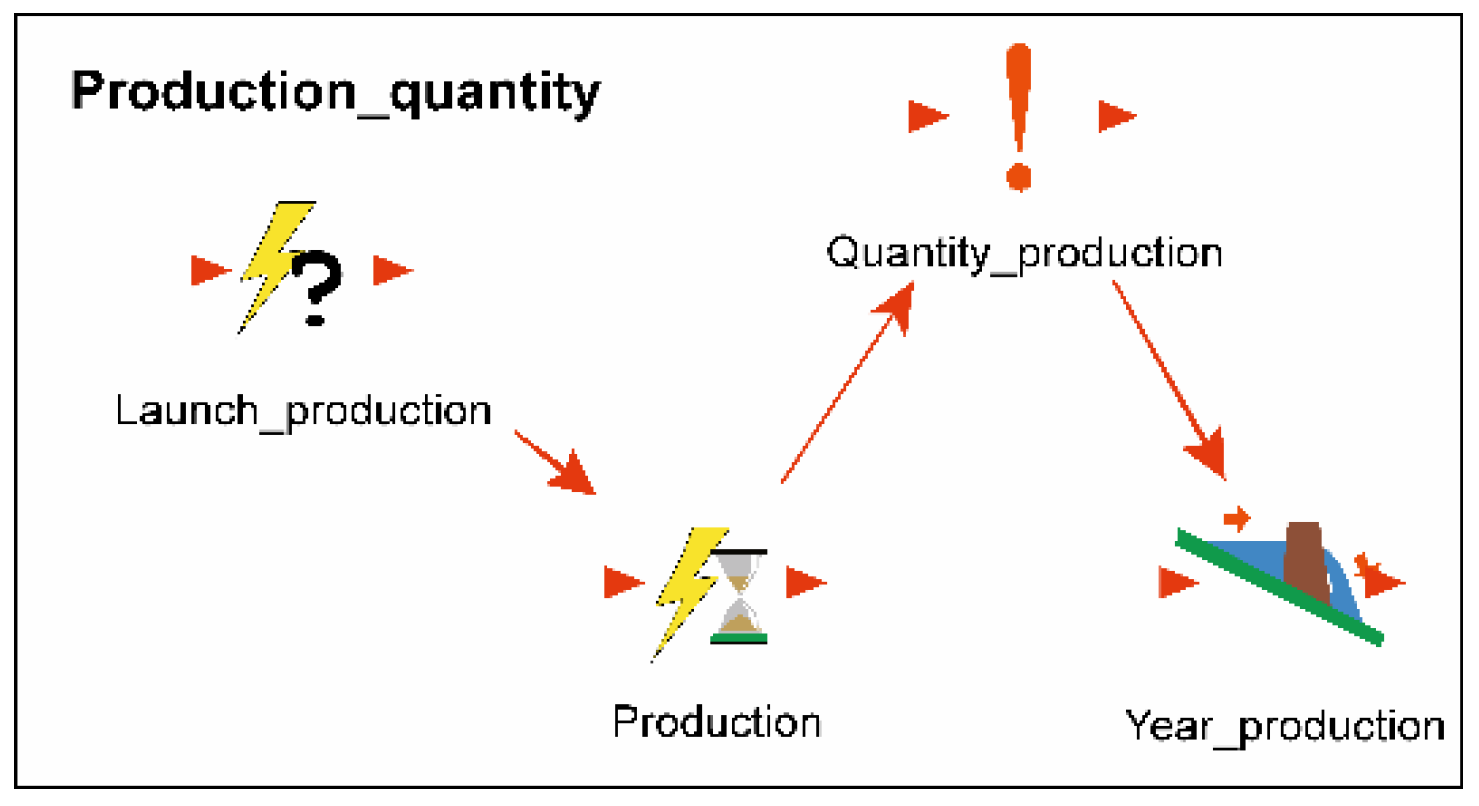
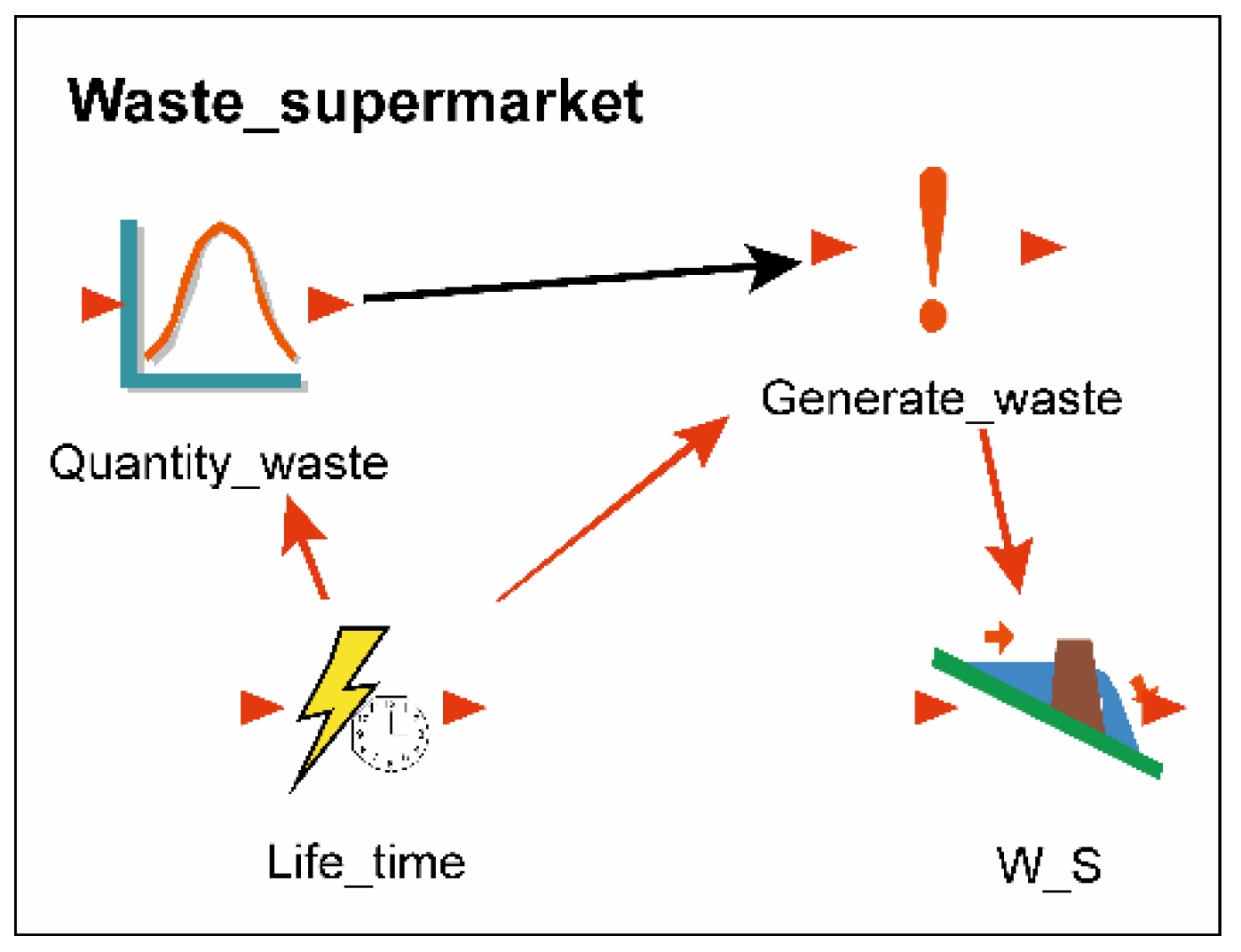

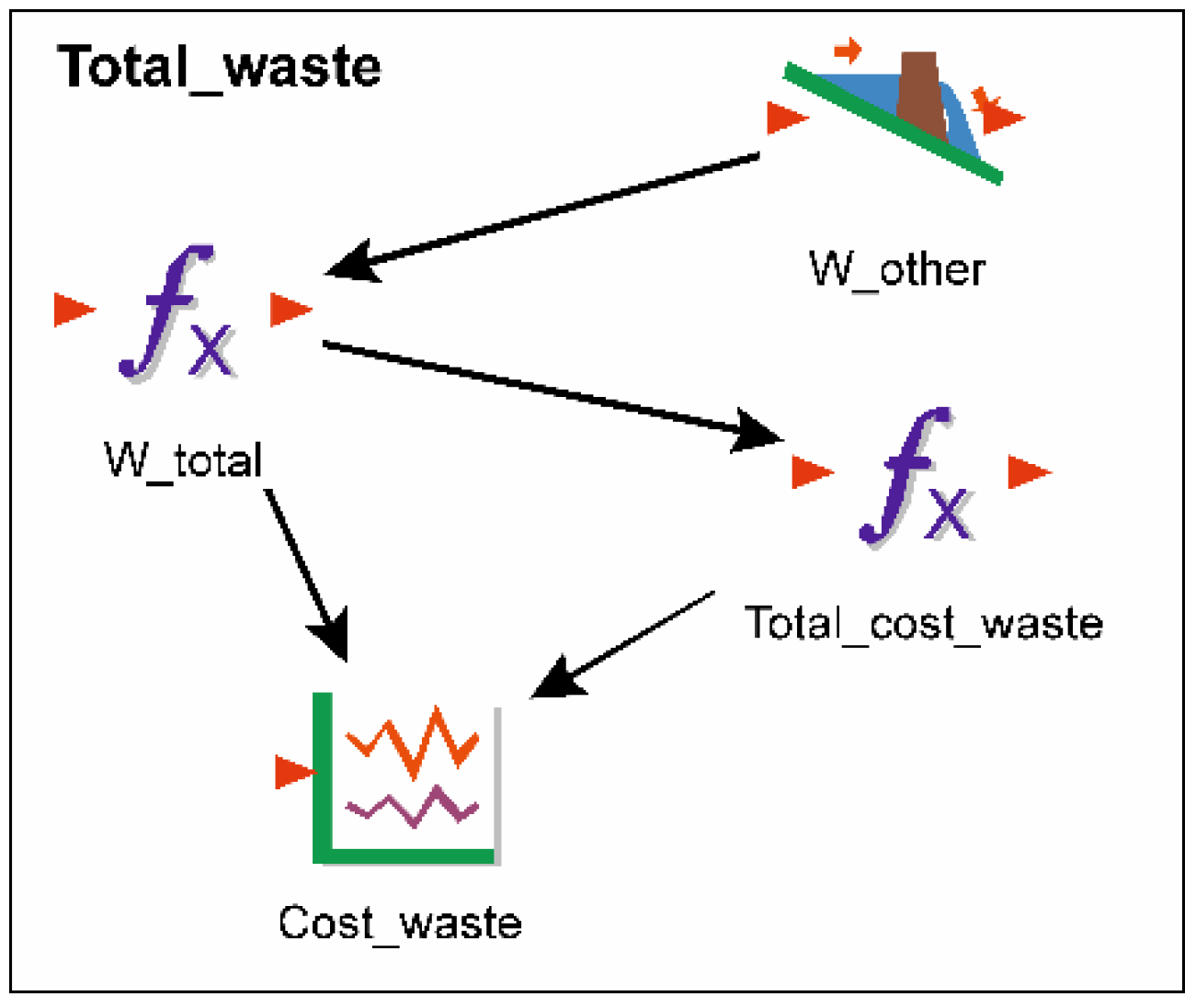
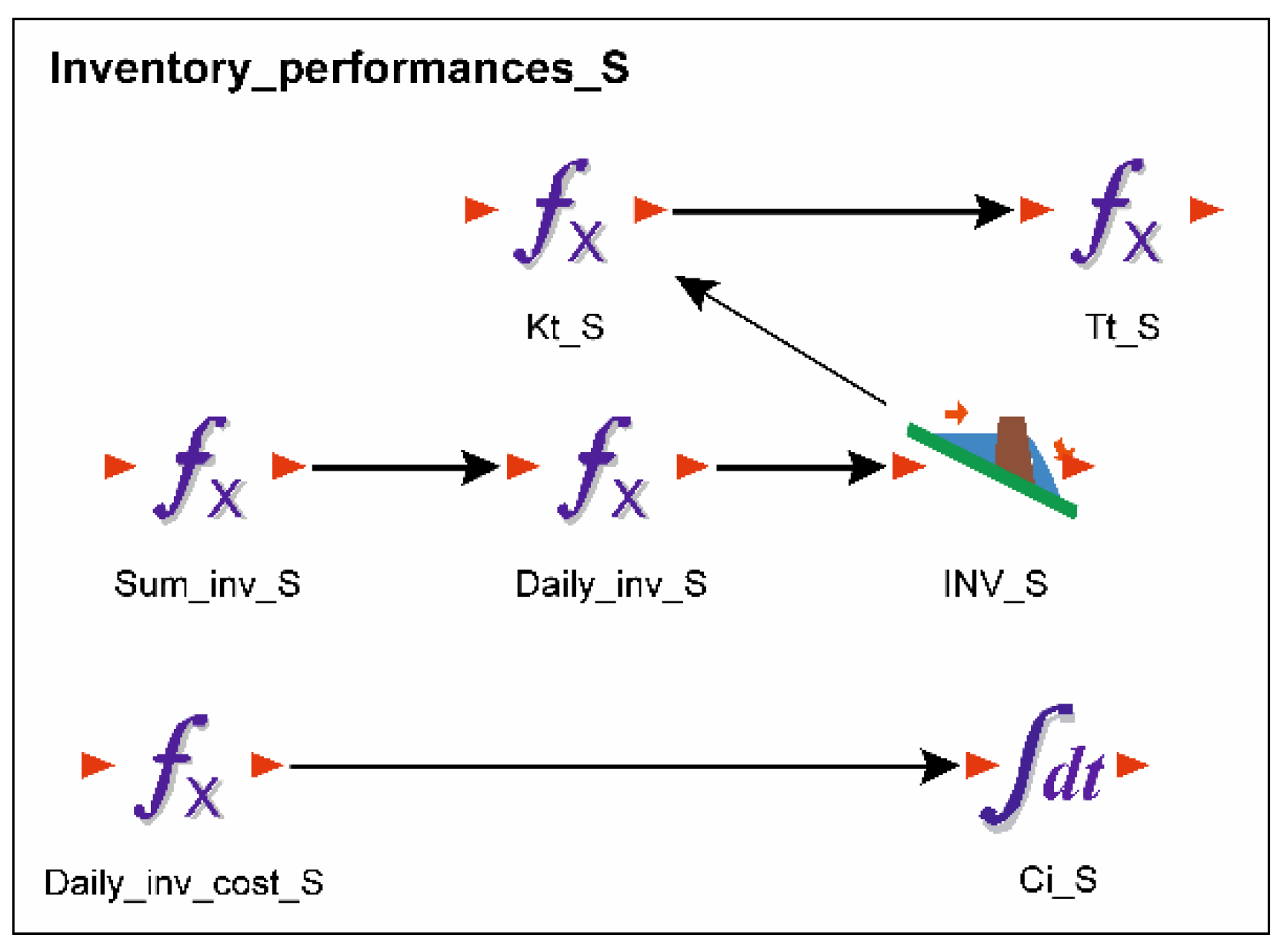
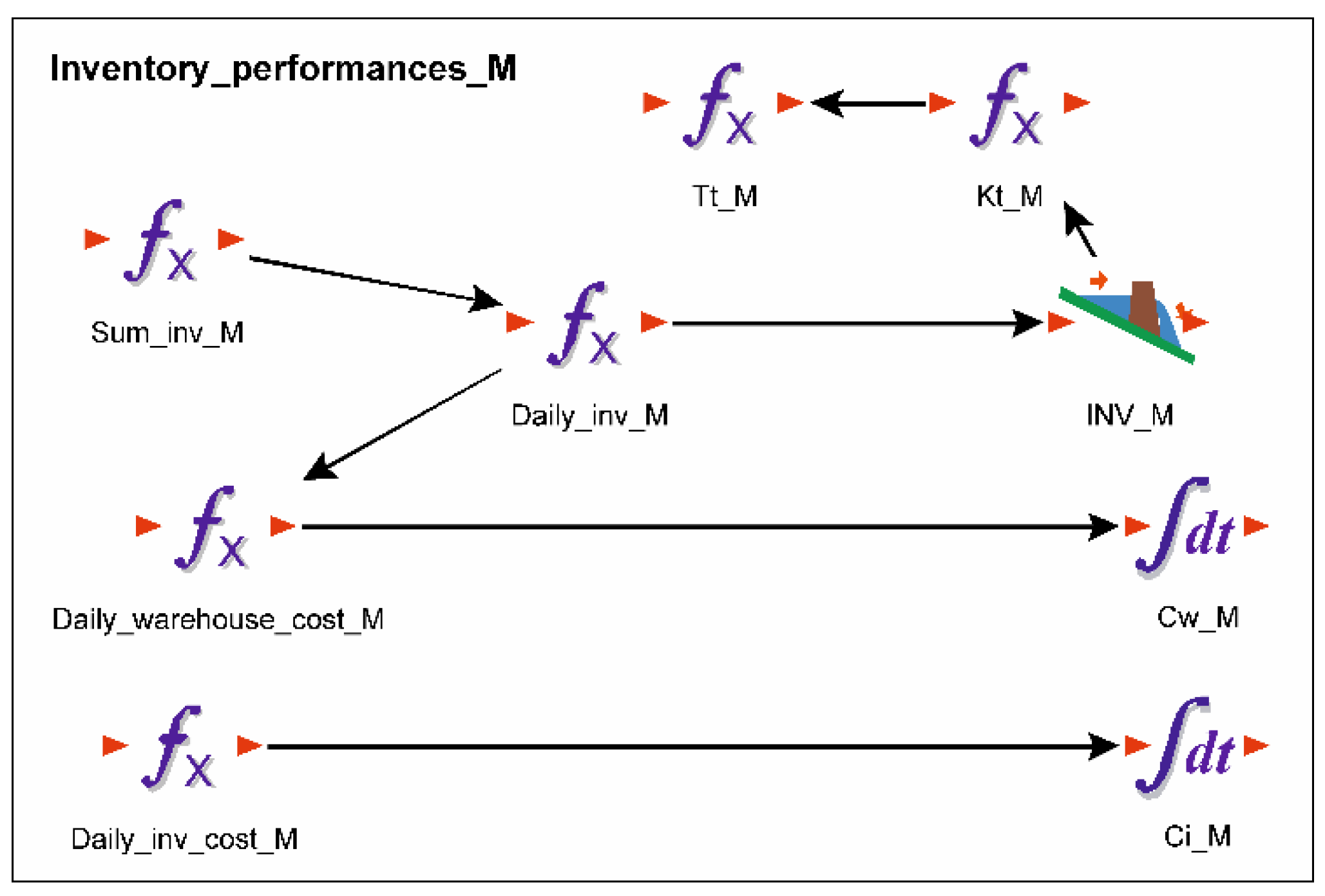
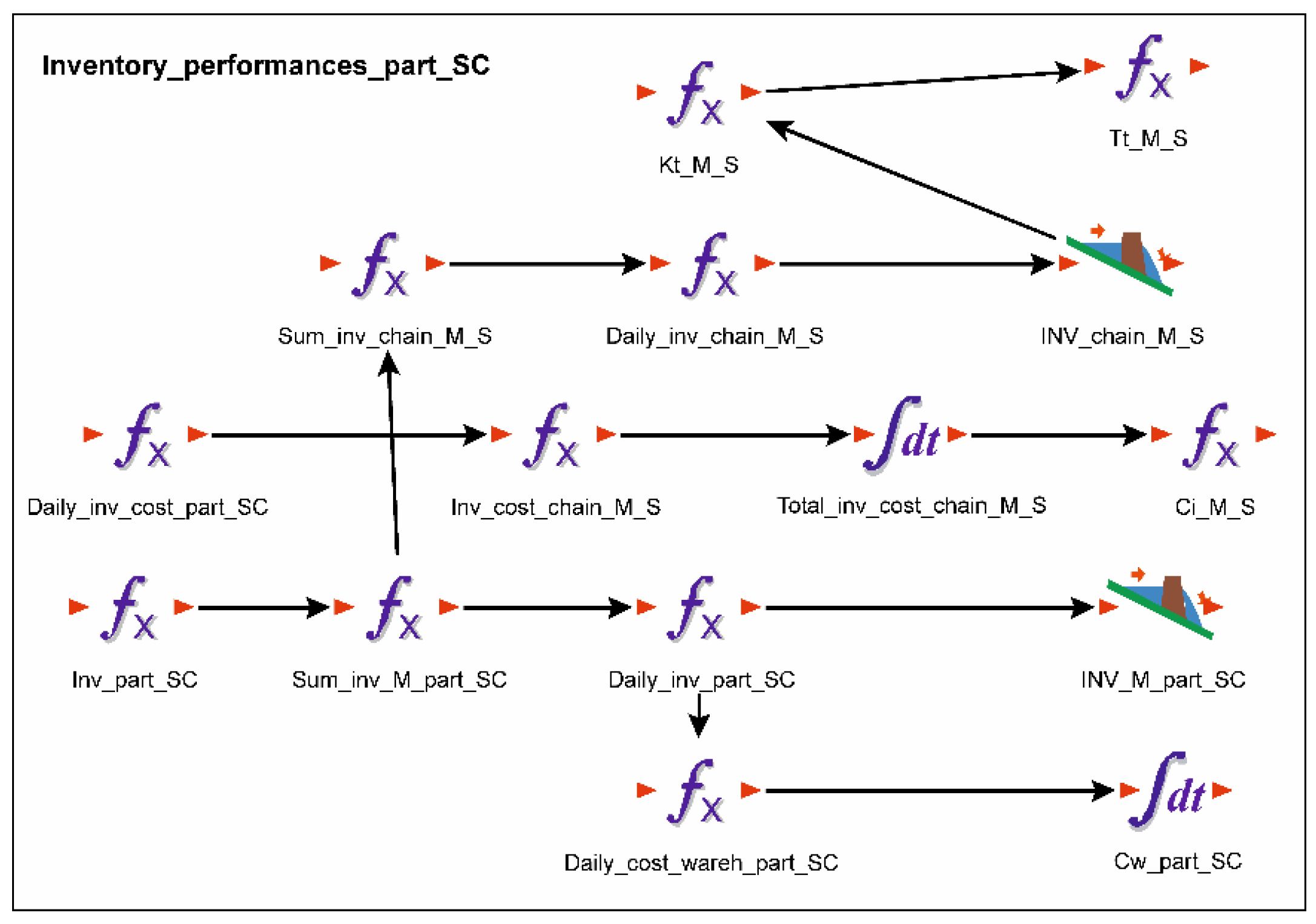
| As-Is State–Model 1 | To-Be State–Model 2 | |||
|---|---|---|---|---|
| Supermarket | Manufacturer | Supermarket | Manufacturer | |
| Product unit | package | package | package | package |
| Replenishment policy | (T, S) | (Q, s) | (T, ss, S) | (Q, s) |
| Review period (T) | every day except Sunday | - | every day except Sunday | - |
| Initial stock level | 9 packages | 2.500 packages | 9 packages | 2.500 packages |
| Ordering stock level (s) | - | 2.700 packages | 1600 packages | |
| Maximum stock level (S) | 10 packages 14 packages-Friday | - | - | |
| Order quantity (Q) | S-state | 5.000 packages | S-state (condition: state ≤ ss) | 10× demand |
| Annual production | - | 145,000 packages | - | 143,000 packages |
| As-Is State–Model 1 | To-Be State–Model 2 | Food Waste Reduction | |||||||
|---|---|---|---|---|---|---|---|---|---|
| Food Waste (Package) | Food Waste (EUR) | Participation * | Food Waste (Package) | Food Waste (EUR) | Participation * | Package | By Weight (%) | By Value (%) | |
| Supermarket | 153 | 971.55 | 8.73 | 108 | 685.80 | 6.65 | 45 | 29.41 | 29.41 |
| Other customers | 15,472 | 98,247.20 | 11.08 | 13,798 | 87,617.30 | 9.91 | 1674 | 10.82 | 10.82 |
| Manufacturer | 3557 | 13,658.88 | 2.45 | 2187 | 8398.08 | 1.53 | 1370 | 38.52 | 38.52 |
| Total | 19,182 | 112,877.63 | 13.23 | 16,093 | 96,701.18 | 8.89 | 3089 | 16.10 | 14.33 |
| Inventory Performances | As-Is State–Model 1 | To-Be State–Model 2 | |||
|---|---|---|---|---|---|
| Part of the Chain for Supermarket | Total Manufacturer | Part of the Chain for Supermarket | Total Manufacturer | ||
| Manufacturer | INVM (package) | 40.75 | 3415.49 | 37.21 | 3118.64 |
| CIM (EUR) | 39.12 | 3279.20 | 35.72 | 2994.19 | |
| nm * | - | 29 | - | 31 | |
| Kt | - | 40.75 | - | 45.35 | |
| Tt (a day) | - | 8.81 | - | 8.05 | |
| CW (EUR) | 19.34 | 1620.65 | 17.66 | 1479.79 | |
| Supermarket | INVS (package) | 10.27 | 8.16 | ||
| CIS (EUR) | 16.31 | 12.95 | |||
| N * | 287 | 258 | |||
| Kt | 152.96 | 190.56 | |||
| Tt (a day) | 2.39 | 1.91 | |||
| Supply chain Manufacturer-Supermarket | INVSM (package) | 51.02 | 45.37 | ||
| CISM (EUR) | 55.43 | 48.68 | |||
| Kt | 30.79 | 34.63 | |||
| Tt (a day) | 11.20 | 9.96 | |||
Publisher’s Note: MDPI stays neutral with regard to jurisdictional claims in published maps and institutional affiliations. |
© 2021 by the authors. Licensee MDPI, Basel, Switzerland. This article is an open access article distributed under the terms and conditions of the Creative Commons Attribution (CC BY) license (https://creativecommons.org/licenses/by/4.0/).
Share and Cite
Nikolicic, S.; Kilibarda, M.; Maslaric, M.; Mircetic, D.; Bojic, S. Reducing Food Waste in the Retail Supply Chains by Improving Efficiency of Logistics Operations. Sustainability 2021, 13, 6511. https://doi.org/10.3390/su13126511
Nikolicic S, Kilibarda M, Maslaric M, Mircetic D, Bojic S. Reducing Food Waste in the Retail Supply Chains by Improving Efficiency of Logistics Operations. Sustainability. 2021; 13(12):6511. https://doi.org/10.3390/su13126511
Chicago/Turabian StyleNikolicic, Svetlana, Milorad Kilibarda, Marinko Maslaric, Dejan Mircetic, and Sanja Bojic. 2021. "Reducing Food Waste in the Retail Supply Chains by Improving Efficiency of Logistics Operations" Sustainability 13, no. 12: 6511. https://doi.org/10.3390/su13126511
APA StyleNikolicic, S., Kilibarda, M., Maslaric, M., Mircetic, D., & Bojic, S. (2021). Reducing Food Waste in the Retail Supply Chains by Improving Efficiency of Logistics Operations. Sustainability, 13(12), 6511. https://doi.org/10.3390/su13126511






